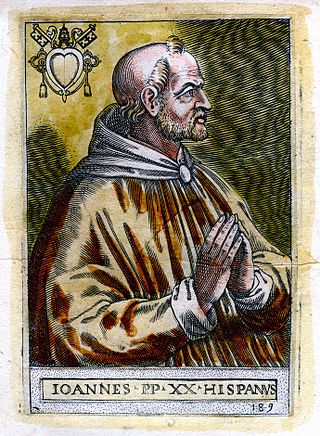Related Research Articles

Pope Gregory X, born Teobaldo Visconti, was head of the Catholic Church and ruler of the Papal States from 1 September 1271 to his death and was a member of the Secular Franciscan Order. He was elected at the conclusion of a papal election that ran from 1268 to 1271, the longest papal election in the history of the Catholic Church.

Pope Nicholas III, born Giovanni Gaetano Orsini, was head of the Catholic Church and ruler of the Papal States from 25 November 1277 to his death on 22 August 1280.

Aldersbach Abbey is a former Cistercian monastery in the community of Aldersbach in the district of Passau in the valley of the Vils, Lower Bavaria, Germany.
Hugh of Evesham was a 13th-century English churchman, physician and alchemist. Given his name, it is likely that he came from Evesham, Worcestershire.
The 1268–71 papal election, following the death of Pope Clement IV, was the longest papal election in the history of the Catholic Church. This was due primarily to political infighting between the cardinals. The election of Teobaldo Visconti as Pope Gregory X was the first example of a papal election by "compromise", that is, by the appointment of a committee of six cardinals agreed to by the other remaining ten. The election occurred more than a year after the magistrates of Viterbo locked the cardinals in, reduced their rations to bread and water, and removed the roof of the Palazzo dei Papi di Viterbo where the election took place.

Vicedomino de Vicedominis was an Italian cardinal.
Stephen (I) Báncsa was the first Hungarian cardinal of the Roman Catholic Church. Prior to that, he served as Bishop of Vác from 1240 or 1241 to 1243, then Archbishop of Esztergom from 1242 until his creation as cardinal.
Bertrand de Saint-Martin was a French cardinal.

The September 1276 papal election is the only papal election to be the third election held in the same year; after Pope Gregory X died, two successors died that year, requiring yet another election. The election was also the first non-conclave, since the establishment of the papal conclave after the papal election, 1268–1271.

Pairis Abbey is a former Cistercian monastery in Orbey in Haut-Rhin, Alsace, northeastern France. The surviving building serves today as a nursing home.
Pope Gregory X (1271–1276) create five cardinals in one consistory.
Pope Urban IV (1261–1264) created fourteen new cardinals in two consistories. The exact dates of these consistories are not clear. Contemporary reports suggest that they were held on 24 December 1261 and in May 1262. However, some modern authors contest the accuracy of these reports as contradicting the established custom of that time, according to which the promotions of cardinals were celebrated on Saturdays of the Ember weeks, which fell on 17 December 1261 and 3 June 1262 respectively.

The 1264–65 papal election was convened after the death of Pope Urban IV and ended by electing his successor Pope Clement IV. It met in Perugia, where Urban IV had taken refuge after being driven out of Orvieto. He had never been in Rome as Pope, but spent his entire reign in exile. It was the second election in a row where a pope was elected in absentia; the phenomenon would be repeated in the Conclave of 1268–1271, and again in the Conclave of 1292–1294. In the last two cases, the person elected was not even a Cardinal.

Matteo Rosso Orsini, was a Roman aristocrat, politician, diplomat, and Roman Catholic Cardinal. He was the nephew of Pope Nicholas III (1277-1280).
Uberto Coconati, a Roman Catholic Cardinal, was born at Asti in the Piedmont region of Italy, a member of the family of the Counts of Cocconato, who were vassals of the Marchese di Monferrato. Thierry de Vaucouleurs, the author of the Johanneslegende, Uberto was "Lombardus nomine, stirpe potens".
Guy de Bourgogne, O.Cist., was a French monk, Abbot, and Cardinal of the Roman Catholic Church.

Guillaume de Bray was a French ecclesiastic and Roman Catholic Cardinal, poet, and mathematician.
Berchtold von Falkenstein was abbot of the Benedictine Abbey of Saint Gall from 1244 until 1272.
References
- ↑ Cf. Björn Gebert, Außerordentlich: Johann von Toledo OCist und seine Kontakte zu Kartäusern und anderen Ordensleuten. Ein Beitrag zur Beziehung zwischen Kartäuserorden und Kurie im 13. Jahrhundert, in: Hermann Josef Roth (ed.), Die Kartäuser im Blickpunkt der Wissenschaften. 35 Jahre internationale Treffen 23.-25. Mai 2014 in der ehemaligen Kölner Kartause (Analecta Cartusiana 310), Salzburg 2015, pp. 113-122, here 115f; Andreas Fischer, Kardinäle im Konklave. Die lange Sedisvakanz der Jahre 1268 bis 1271 (Bibliothek des Deutschen Historischen Instituts in rom 118), Tübingen 2008, pp. 56-72, here 56-58.
- 1 2 Bellenger, Dominic Aidan; Fletcher, Stella (2001). Princes of the Church: A History of the English Cardinals. Stroud, UK: Sutton. p. 173. ISBN 0-7509-2630-9.